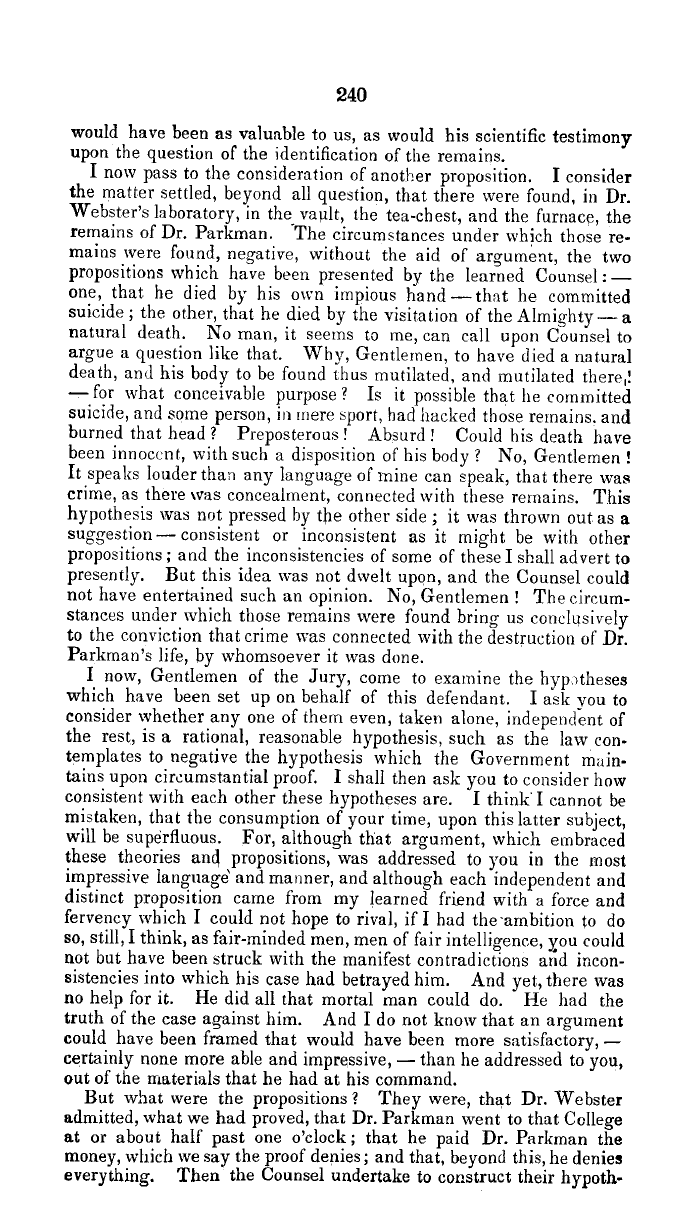|
240
would have been as valuable to us, as would his scientific testimony
upon the question of the identification of the remains.
I now pass to the consideration of another proposition. I consider
the matter settled, beyond all question, that there were found, in Dr.
Webster's laboratory, in the vault, the tea-chest, and the furnace, the
remains of Dr. Parkman. The circumstances under which those re-
mains were found, negative, without the aid of argument, the two
propositions which have been presented by the learned Counsel:-
one, that. he died by his own impious hand-that he committed
suicide ; the other, that he died by the visitation of the Almighty- a
natural death. No man, it seems to me, can call upon Counsel to
argue a question like that. Why, Gentlemen, to have died a natural
death, and his body to be found thus mutilated, and mutilated there,!
-for what conceivable purpose? Is it possible that lie committed
suicide, and some person, in mere sport, had hacked those remains. and
burned that head ? Preposterous! Absurd! Could his death have
been innoccnt, with such a disposition of his body ? No, Gentlemen !
It speaks louder than any language of mine can speak, that there was
crime, as there was concealment, connected with these remains. This
hypothesis was not pressed by tire other side ; it was thrown out as a
suggestion-consistent or inconsistent as it might be with other
propositions ; and the inconsistencies of some of these I shall advert to
presently. But this idea was not dwelt upon, and the Counsel could
not have entertained such an opinion. No, Gentlemen ! The circum-
stances under which those remains were found bring us conclusively
to the conviction that crime was connected with the destruction of Dr.
Parkman's life, by whomsoever it was done.
I now, Gentlemen of the Jury, come to examine the hyp..)theses
which have been set up on behalf of this defendant. I ask you to
consider whether any one of them even, taken alone, independent of
the rest, is a rational, reasonable hypothesis, such as the law con.
templates to negative the hypothesis which the Government main-
tains upon circumstantial proof. I shall then ask you to consider how
consistent with each other these hypotheses are. I think I cannot be
mistaken, that the consumption of your time, upon thislatter subject,
will be superfluous. For, although that argument, which embraced
these theories and propositions, was addressed to you in the most
impressive language andmanner, and although each independent and
distinct proposition came from my learned friend with a force and
fervency which I could not hope to rival, if I had the-ambition to do
so, still, I think, as fair-minded men, men of fair intelligence, you could
not but have been struck with the manifest contradictions arid incon-
sistencies into which his case had betrayed him. And yet, there was
no help for it. He did all that mortal man could do. He had the
truth of the case against him. And I do not know that an argument
could have been framed that would have been more satisfactory, -
certainly none more able and impressive, - than he addressed to you,
out of the materials that he had at his command.
But what were the propositions ? They were, that Dr. Webster
admitted, what we had proved, that Dr. Parkman went to that College
at or about half past one o'clock; that he paid Dr. Parkman the
money, which we say the proof denies; and that, beyond this, he denies
everything. Then the Counsel undertake to construct their hypoth-
|

